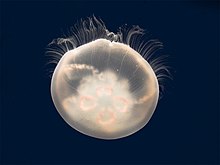
Back شعاعية التماثل Arabic Прамяністыя BE-X-OLD Радиалносиметрични Bulgarian Radiats Catalan Radiata CEB Láčkovci Czech Radiata German Radiata English Radiuloj Esperanto Radiata Spanish
| Radiata Temporal range: Ediacaran – Recent
| |
|---|---|

| |
| A moon jellyfish, Aurelia aurita | |
| Scientific classification | |
| Kingdom: | |
| Subkingdom: | |
| (unranked): | Radiata Linnaeus, 1758
|
| Phyla | |
The Radiata is a superphylum which includes both the echinoderms and the ctenophores. It is not part of the usual classification system, and is not used by all biologists.[1][2]
The group includes the radially symmetric animals of the Eumetazoa. The echinoderms, however, are members of the Bilateria, because they exhibit bilateral symmetry in their developing stages. Their radial symmetry is secondary.
Thomas Cavalier-Smith in 1983 defined a subkingdom called Radiata consisting of the phyla Porifera, Myxozoa, Placozoa, Cnidaria and Ctenophora in Radiata, that is, all the animals that are not in Bilateria.
The Five Kingdom classification of Lynn Margulis and K.V. Schwartz keeps only Cnidaria and Ctenophora in Radiata.
Cladistic classifications do not recognize Radiata as a clade. The radiata, in this sense, are diploblastic, meaning they have two primary germ layers: endoderm and ectoderm. Cavalier-Smith's use of the term Radiata includes animals with a single germ layer such as sponges.
Although radial symmetry is usually given as a defining characteristic of radiates, a few members of the class Anthozoa, which are now considered as the most basal and oldest group of cnidarians, are actually bilaterally symmetric.
Newer research strongly indicates that bilateral symmetry evolved before the split between Cnidaria and Bilateria: the radially symmetrical cnidarians have evolved radial symmetry secondarily. This means the bilaterism in species like N. vectensis has a primary origin. Also the free-swimming planula larvae of cnidarians exhibit bilateral symmetry. Ctenophores show biradial symmetry.[3]
- ↑ Nielsen, Claus 2002. Animal evolution: interrelationships of the living phyla. 2nd ed, Oxford University Press. Eumetazoa p51; Cnidaria p60; Ctenophora p72.
- ↑ Valentine, James 2004. On the origin of phyla. Chicago University Press. p214 Cnidarians and Cnidariomorphs; p228 Ctenophora
- ↑ Mark Q. Martindale AND Jonathan Q. Henry 1998. The American Zoologist.The development of radial and biradial symmetry: The evolution of bilaterality Archived 2007-11-21 at the Wayback Machine - retrieved February 2, 2006